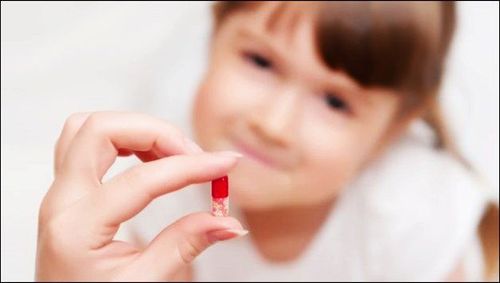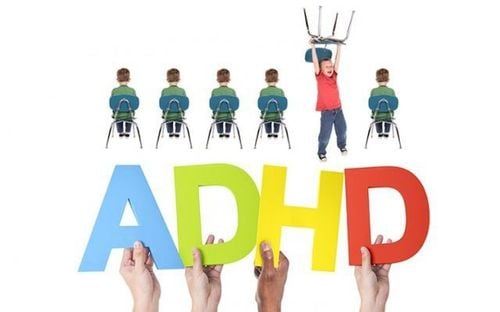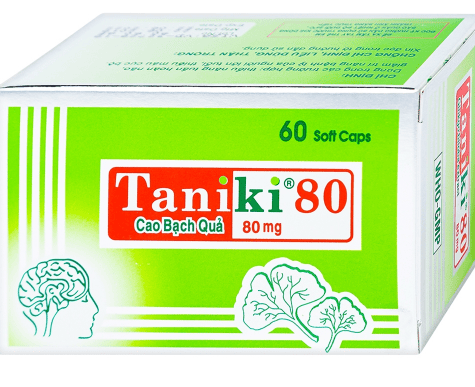This is an automatically translated article.
Attention Deficit/ Hyperactivity Disorder (ADHD) is a common disorder in children and today tends to increase in school age. This causes many serious consequences and affects the quality of children's learning and life. The following article will provide you with some information about this disorder and the treatments for attention deficit hyperactivity disorder.
1. Characteristics of Attention Deficit Hyperactivity Disorder Attention Deficit Hyperactivity Disorder (ADHD) is a neurodevelopmental disorder. This is a disease of the nervous system that appears early in childhood, especially before school, and leads to underdevelopment in aspects such as personal and academic. Typically problems involve difficulty acquiring, retaining, and applying the skills or information provided. Manifestations of neurodevelopmental disorders may include dysfunction of reflexes, problem solving, memory, language, perception, or interactions with the outside world. Other common neurodevelopmental disorders include: autism or mental retardation.
Some surveys have shown that ADHD affects about 5 - 11% of school-age children such as preschool and primary school. However, specialists say that ADHD is often overdiagnosed, which leads to incorrect treatment. The Diagnostic and Statistical Manual of Mental Disord reports that there are three common types of ADHD:
Attention deficit hyperactivity or impulsivity Can combine the two above Statistics have shown that in boys there is an increased incidence of ADHD almost twice as high as that of girls and vary by type. Predominant hyperactivity or impulsivity is 2-9 times more common in boys than in girls, while inattention is equally prevalent in both sexes. In particular, ADHD runs in families.

Giải đáp tăng động giảm chú ý có chữa được không?
2. Causes of ADHD There are no exact causes. Some of the more common causes are related to genetic, biochemical, physiological, behavioral factors or the neuro-sensory system. In addition, there are some risk factors leading to ADHD such as:
Low birth weight babies under 1500 g Accidental head injury Vitamin deficiency, iron deficiency Child exposure to lead or the mother's use of alcohol or drugs leaves during pregnancy.
3. Diagnosis of Attention Deficit Hyperactivity Disorder 3.1. Guidelines for the diagnosis of ADHD The patient must have both attention deficit and hyperactivity-impulsivity criteria. Both of the above disorders appear in the early stage before the age of 5 (ICD - 10), before the age of 7 (DSM - IV) and the manifestations must be very clear compared to peers of the same age and compared with the period. develope. The disturbances must be present in multiple settings such as family, school, and society, simultaneously, and last for at least 6 months. There must be clear evidence of the adverse effects of this disorder on social functioning, peer relationships, learning impairments, and obstacles to normal age-appropriate development. . It is necessary to exclude those disorders that are not caused by schizophrenia or autism or other mental disorders such as anxiety, affective disorders, personality disorders... 3.2. Diagnostic criteria for ADHD Symptoms of ADHD are divided into 3 main groups of behavioral symptoms with the following ways in which the child behaves:
Attention deficit
At least 6 of the following symptoms and symptoms persist for at least 6 months with a degree that makes the patient poorly adapted to the surrounding environment or is not suitable for mental development at that age:
Often easily distracted by external stimuli. Often do not want to listen to other people speak directly. Often can't sustain attention at work, study or play Often can't pay attention to details and thus make mistakes in learning or playing. Often doesn't follow directions for doing something, or doesn't complete homework or get work done without doing it on purpose. Often encounters many difficulties in organizing and organizing work and activities. Often lost tools, furniture such as toys, learning tools, equipment. Often forgets to do daily tasks. Often avoids and doesn't want to do tasks that require attention or high concentration, such as homework. Hyperactivity
Usually moves quickly, hastily. Often intends to leave their seats in the classroom or at other times when it is necessary to sit still. Limbs are always active, standing still. Often has a tendency to run, jump or climb at inappropriate times and potentially endanger oneself. It is often difficult to participate in activities that require silence. Impulsive
Often works and speaks spontaneously, without thinking. Run across the road despite the danger. Don't want to wait in line to wait for your turn. Always interrupting others to speak or forcing answers before being asked Interrupt or disturb others by interjecting in the middle of a conversation or ruining a game.

Có thể điều trị tăng động giảm chú ý bằng thuốc
4. Intervention methods for children with ADHD The question often asked by many parents is can ADHD be cured? The answer is that ADHD can be treated with a combination of chemotherapy and psychotherapy.
4.1. Drug treatment Children over 3 years old can use Dextroamphetamine or Methylphenidate for children 6 years and older. These two drugs belong to the group of psychotropic substances that stimulate the central nervous system and are recommended for use in children and are not addictive. In cases of concomitant depression and anxiety, tricyclic antidepressants and selective serotonin reuptake inhibitors can be used. 4.2. Psychological intervention therapy This is a method of treating attention deficit hyperactivity disorder that plays an important and long-lasting role during the treatment process for children. This therapy requires close cooperation with parents to get the right care to bring the best results. Measures that parents can apply to their children include:
Develop specific, clear and concise rules so that children can understand what parents want from them. Increase responsibility and self-discipline for children by assigning tasks and rewards will be achieved if done well. Together with children, build a plan and track and remind to complete all tasks. Make it a habit for your child to pay attention to what you are saying. Give your child proper attention by finding strengths to encourage and weaknesses to help them improve themselves. Let children play thinking games and avoid violent games. Encourage children to participate in sports activities appropriate to their age and health. Always remind your child to follow the rules and regulations in public places. Avoid scolding and criticizing children, but instead should analyze right and wrong so that children can understand. Children are hyperactive, obedient but very vulnerable. Therefore, when suffering from attention deficit hyperactivity disorder, parents should give their children proper love and attention to accompany them through this period. When realizing that a child has abnormal signs, parents should take the child to a specialized medical facility for examination and appropriate treatment.
With the desire to better take care of the mental health of adults and children, Vinmec International General Hospital officially put the High-Tech Treatment Center for Cerebral Palsy & Autism into operation with visiting services. examining, detecting and treating autism by psychological methods, music, meditation, yoga... Vinmec is also conducting research on stem cell transplantation to treat autism with many positive results. Vinmec is one of the few medical centers in the world that specializes in stem cell transplantation for autism treatment. Due to the strong and methodical investment, although it is late, the studies at Vinmec are considered to bring even more positive results. While the world widely uses the method of "pumping" stem cells into the veins, the amount of stem cells is greatly reduced. These cells are "diluted" in the circulatory system, the rate of reaching the brain is not much, but Vinmec does it by transmitting through the spinal cavity, connecting directly with the brain, helping the cell density to reach the brain higher. .
Please dial HOTLINE for more information or register for an appointment HERE. Download MyVinmec app to make appointments faster and to manage your bookings easily.












